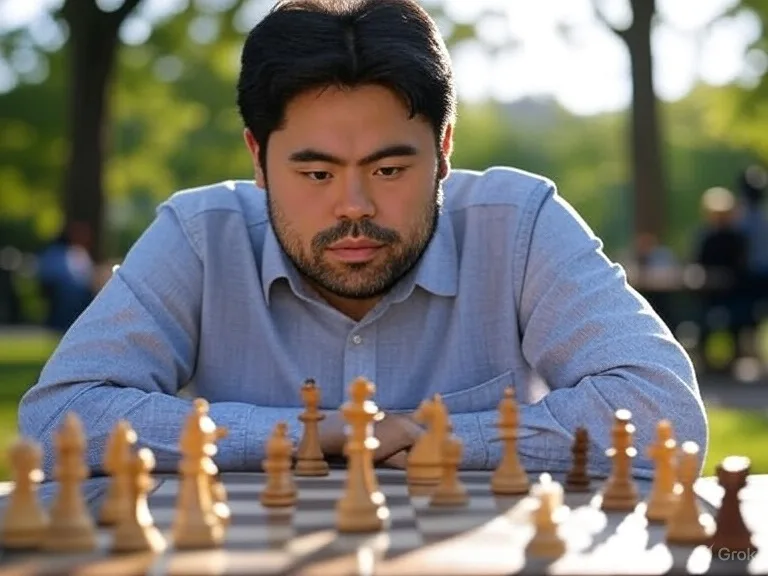Grandmaster Hikaru Nakamura once again shocked the American chess scene by entering a modest state-level tournament. This time it was the 70th Iowa Open Championship in Iowa City, where he faced opponents rated far below his world-class level.
The two-day event, held September 6-7 at The Graduate Hotel, was run under a five-round Swiss system with a classical time control of 90 minutes plus a 30-second increment. It drew 55 players from across the U.S. and abroad, competing for a total prize fund of $2,200. The winner’s prize was $750 and a trophy – an amount trivial for Nakamura, but life-changing for many club players who entered.
An Unlikely Guest Among Local Players
The tournament was headlined by Nakamura, who registered with a FIDE rating of 2807. The gap to the second seed, Candidate Master Anjaneya Sripathy Rao (2147 FIDE), was a staggering 660 points. Further down the list were players like Valeriy Kosokin of Uzbekistan (2143), Tim McEntee (1931), Alec Daniel Aimdilokwong (2017), and Kyler Weatherspoon (1970).
Most of the field were in the 1800–2000 range, including familiar Iowa names such as Dane Bruno Zagar (1950), Luke Hengen (1896), and Edward Shen (1966). Others were ambitious juniors: Elijah Logozar (1937), Niko Nixon (1834), and Aaron Jing (1843). For them, sitting across from Nakamura wasn’t just another round – it was a once-in-a-lifetime moment.
Lower-rated competitors also filled the hall, from 1600-rated teenagers to unrated beginners. One of the youngest participants, Vivaan Parameswaran (1279), could hardly hide his excitement: “I know I’ll lose quickly, but I’ll get to say I played Hikaru Nakamura.”
Prize Money vs. Prestige
The top prize of $750 was never Nakamura’s motivation. Compared to his Twitch and YouTube streaming revenue, the money was symbolic. But for local experts and class players, the stakes were real. Players like Joseph Pregon (1885), Oliver Ohly (1791), and Veronique Joseph (1752) were chasing not just prizes in their rating categories, but also the prestige of testing themselves in a field suddenly upgraded by the presence of a global superstar.
In the opening round, Nakamura faced Benjamin Darr, a 1915-rated local player. The result was never in doubt, but what stood out was the manner of victory. Playing White, Nakamura finished the game with more time on his clock than he started with – 1 hour 31 minutes and 34 seconds compared to the initial 1 hour 30 minutes. Thanks to the 30-second increment, he built time instead of spending it, a display of effortless control.
The game itself was smooth: a quiet London-style setup turned into a tactical squeeze, ending on move 25 when Darr’s defenses collapsed. For Darr, it was a short but unforgettable experience. For Nakamura, it was business as usual – a masterclass in efficiency against a vastly lower-rated opponent.
A Repeat of Louisiana
Nakamura’s participation came just a week after he swept the Louisiana State Championship 7/7. That victory raised his live rating to 2811.8 and reignited debates about the Candidates Tournament qualification system. To be eligible for the rating spot, Nakamura must play at least 40 classical games before January 1, 2026. With only 18 games played earlier this year, he now needs every weekend tournament he can find.
Iowa offered five more games, relatively risk-free compared to elite competitions. Against opponents rated 600–1,500 points below him, Nakamura’s challenge wasn’t whether he would win, but whether he could win cleanly enough to avoid small rating losses.
The Experience for Iowa Players
For many locals, the result was never in doubt. But that didn’t matter. Facing Nakamura was a story they could tell for years. “It was the most nerve-wracking game of my life,” said one 1900-rated player. “You don’t prepare to win, you prepare to survive 20 moves.”
Others saw it as a gift to the community. “The Iowa Open usually gets about 50-60 players and some masters,” said a long-time competitor. “But this year, people will talk about it around the country. That’s special.”
Even the hotel staff felt the difference. The Graduate Hotel, with its $139-per-night tournament rate, suddenly hosted one of the world’s most famous grandmasters. “Guests were asking for autographs in the lobby,” one staff member laughed.
The Larger Debate
Online, the criticism remained familiar. Was this “rating farming”? Was it fair for a top-three player in the world to enter a state championship designed for local amateurs? International Master Levy Rozman has already called the situation a flaw of FIDE’s system, not of Nakamura himself.
Yet for Iowa, the atmosphere was celebratory. Nakamura’s games attracted crowds the moment they ended. Younger players lined up for photos. “I don’t care if he’s here for the Candidates,” said one player. “It’s amazing that he’s here at all.”
What It Means Going Forward
With Louisiana and Iowa combined, Nakamura has added 12 more classical games to his tally, moving him closer to the 40 required. More state championships – perhaps Minnesota, Illinois, or Wisconsin – may be on his list before the year ends.
For now, the scoreboard looks familiar: Nakamura, perfect at Louisiana, heavily favored in Iowa. The only suspense is whether he can turn these small tournaments into the stepping stones that carry him to the 2026 Candidates Tournament – and possibly back into a world championship match.
For the Iowa Open, the 70th edition will forever be remembered not for who won $750, but for the weekend when one of the greatest players of his generation chose to spend two days in Iowa City, giving local competitors the game of their lives.
I’m the senior editor of Attacking Chess, a keen chess player, rated above 2300 in chess.com. You can challenge me or asking questions at Chess.com.

